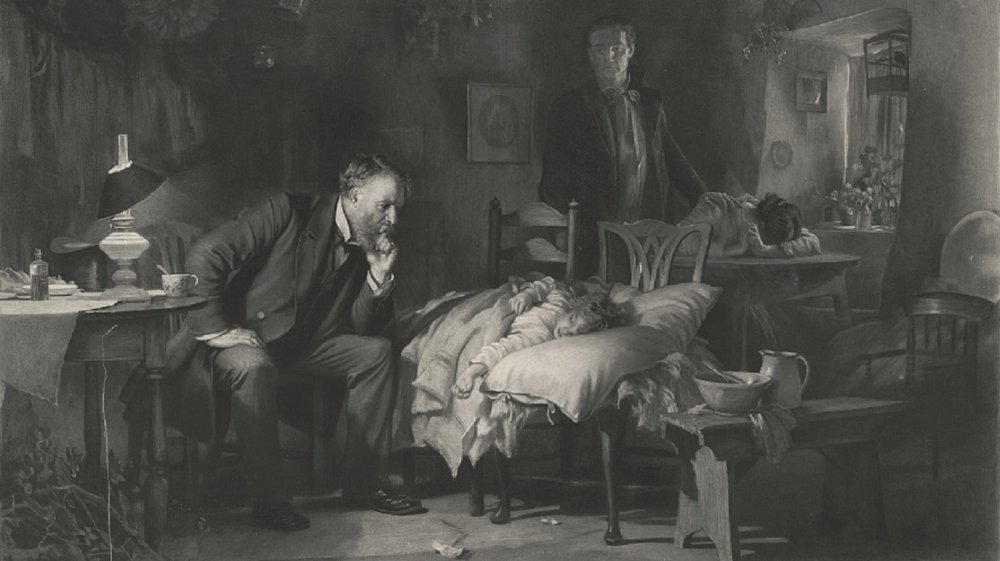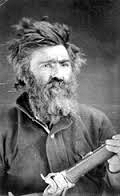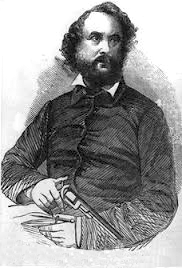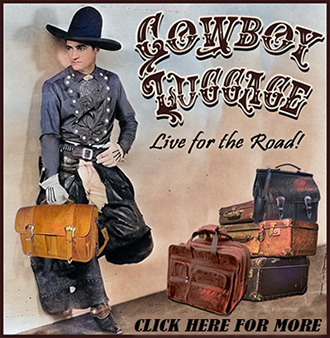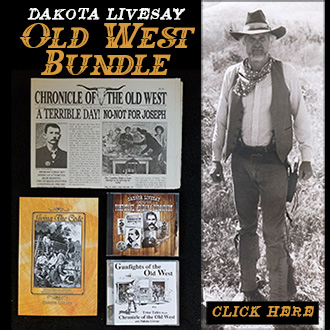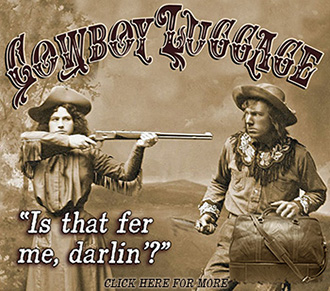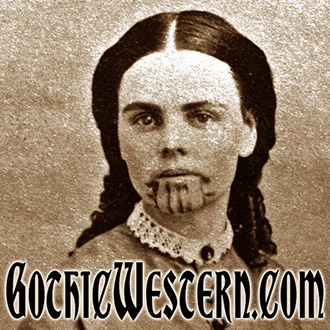Billy the Kid Photo
 Years ago I commented on the Billy the Kid PBS special and how the famous Billy the Kid photo kept appearing on the screen over and over. That’s because there are only two authentic photographs of Billy the Kid presently in existence. The most famous one is a two-by-three-inch ferrotype or tintype, taken by an unknown itinerant photographer outside Beaver Smith’s Saloon in Old Fort Sumner, around 1880…Because it portrays Billy as a very unattractive person, many have called it his visa picture.
Years ago I commented on the Billy the Kid PBS special and how the famous Billy the Kid photo kept appearing on the screen over and over. That’s because there are only two authentic photographs of Billy the Kid presently in existence. The most famous one is a two-by-three-inch ferrotype or tintype, taken by an unknown itinerant photographer outside Beaver Smith’s Saloon in Old Fort Sumner, around 1880…Because it portrays Billy as a very unattractive person, many have called it his visa picture.
Originally people didn’t realize that since it was a tintype, the image was actually reversed. So, everyone though Billy the Kid was left handed. This misconception even inspired the 1958 movie “The Left Handed Gun,” starring Paul Newman as Billy.
Finally firearms experts looked at the Kid’s Winchester and noticed its spring plate, where the cartridges are loaded, was on the left side. But Winchester produced firearms with spring plates only on the right side. So, later books and publications have the reversed image reversed, so it’s correct.
Recently the Billy the Kid photo went on the auction block and a retired Wichita industrialist who collects everything from Wild West memorabilia to Picassos bought it for $2 million…Incidentally, it was thought it would go for about $300,000.
Salted Undershirt
March 1, 1892, Daily Herald, El Paso, Texas – Five years ago I was suffering with a very severe throat trouble, so much so that I did not expect to live. An acquaintance told me that he could give me a remedy that would cure it and , as I had tried all of the doctors in my town without receiving any benefit, I decided to try the remedy suggested. I tried it, was permanently cured of my cough, and besides I discovered that I was not subject to colds.
I was conductor, running in the states of Virginia, North Carolina, South Carolina, Georgia, Florida, Tennessee and Alabama. I was of course subjected to very hot cars in winter, and of necessity had constantly to get out in the cold at all hours of the night. In all that time I have never had a cold or the grip. You will be astonished at the remedy. It is simply to wear a salted undershirt.
Take a summer undershirt and soak it in brine made with, a half pint of ordinary salt to about a quarter of water, and put out to dry. Wear this shirt next to the body. It is not unpleasant to wear and will, I am sure, keep off grip and bad colds, and, I firmly believe, consumption. If I were to live to be eighty years old, I have so much faith in the salted shirts that I would never cease to wear them. My reason for preferring the thin gauze shirt is because the salt makes a heavy shirt too stiff and hard. Wear the heavy shirt over the salted shirt
NOTE: This article written in 1892. It was the latest in medical news back then, but not necessarily now.
Bat Masterson – Gunfighter
 I find Bat Masterson one of the more intriguing men of the Old West. He is known as a gunfighter, but he was in very few gun fights.
I find Bat Masterson one of the more intriguing men of the Old West. He is known as a gunfighter, but he was in very few gun fights.
The last gunfight he was in took place on this day back in 1881. It was to help out his brother Jim. Jim owned a business in Dodge City and was having trouble with Al Updegraff, a business partner. It had even involved gunfire.
I don’t know if Jim actually said the words, “I going to get my big brother and he’ll beat you up,” but Bat, in Tombstone at the time, heard about the conflict and jumped on a train to Dodge City.
Not a man to mince words, Bat immediately spotted Updegraff and brother-in-law Peacock and said, “I have come over a thousand miles to settle this. I know you are heeled, now fight!” All three men immediately drew their guns.
In the fracas Updegraff took a bullet in his right lung. The mayor and sheriff arrived with shotguns and stopped the shooting. No one was mortally injured in the shooting, and in accordance with Old West standards, the gunfight was fought fairly. So Masterson was fined $8. He paid the fine and took the next train out of Dodge City.
As an aside, had Bat not left Tombstone to help his brother, the chances are excellent he would have been around to help his friend Wyatt Earp in another gunfight…The one that took place at the OK Corral.
Hiram Rhoades Revels, First Black Congressman
 In 1870 Hiram Rhoades Revels, a Republican from Natchez, Mississippi, was sworn into the U.S. Senate, becoming the first Black ever to sit in Congress.
In 1870 Hiram Rhoades Revels, a Republican from Natchez, Mississippi, was sworn into the U.S. Senate, becoming the first Black ever to sit in Congress.
During the Civil War, Revels, a college-educated minister, helped form Black army regiments for the Union cause, started a school for freed men, and served as a chaplain for the Union Army. Revels remained in the former Confederate state after the war and entered into Reconstruction-era Southern politics.
In 1865, Revels left the AME Church, the first independent black denomination in the US, and joined the Methodist Episcopal Church. He was assigned briefly to churches in Leavenworth, Kansas, and New Orleans, Louisiana. In 1866, he was called as a permanent pastor at a church in Natchez, Mississippi, where he settled with his wife and five daughters. He became an elder in the Mississippi District of the Methodist Church, continued his ministerial work, and founded schools for black children.
During Reconstruction, Revels was elected alderman in Natchez in 1868. In 1869 he was elected to represent Adams County in the Mississippi State Senate.
It’s interesting to note that the Senate seat Revels held was once held by Jefferson David, the former president of the Confederacy.
The Passing of the Old West Boots
Considering the popularity of Old West boots today, here is an interesting article from 1894.
Disuse of Foot Gear Once Popular East and West.
 November 7, 1894, Evening News, El Paso, Texas – The diminished use of boots is a matter of concern to the manufacturers of them and to the producers of heavy leather and heavy calfskins. Twenty years ago the calf boot industry was a leading one in New England. Whole towns were studded with factories, which produced calf boots exclusively. For a decade the sale has been gradually falling off, and today it is of hardly any importance.
November 7, 1894, Evening News, El Paso, Texas – The diminished use of boots is a matter of concern to the manufacturers of them and to the producers of heavy leather and heavy calfskins. Twenty years ago the calf boot industry was a leading one in New England. Whole towns were studded with factories, which produced calf boots exclusively. For a decade the sale has been gradually falling off, and today it is of hardly any importance.
A few manufacturers of shoes include boots as a specialty, but the demand is too light to amount to much. When calf boots were more in vogue, manufacturers consulted the partialities of the cowboys, to whom price was a secondary consideration. The legs were frequently corded with silk stitching. The star and crescent and other fanciful ornamentations were inlaid on the legs of the boots. There were high heels, and boots were striking specimens of mechanical art. The soles were inlaid with copper, zinc and brass nails.
The cowboys no longer pay $15 for a pair of boots. They want substance instead of show. But they were not the only wearers of calf boots. They were extensively worn. Many men prefer them today, though the number is growing less.
The old-fashioned stoga boots were formerly sold in large quantities. They are well nigh obsolete. There followed a demand for a lighter and more stylish article. A kip boot of finer texture was produced, about equal in appearance to the best calf boot, but this, too, has fallen somewhat into disuse, and the sales this season are scarcely over one-half the usual amount. Even the farmers are using heavy shoes instead of boots, and if it becomes a necessity to wear long legged boots they buy rubber.
Marion Hedgepeth and H.H. Holmes
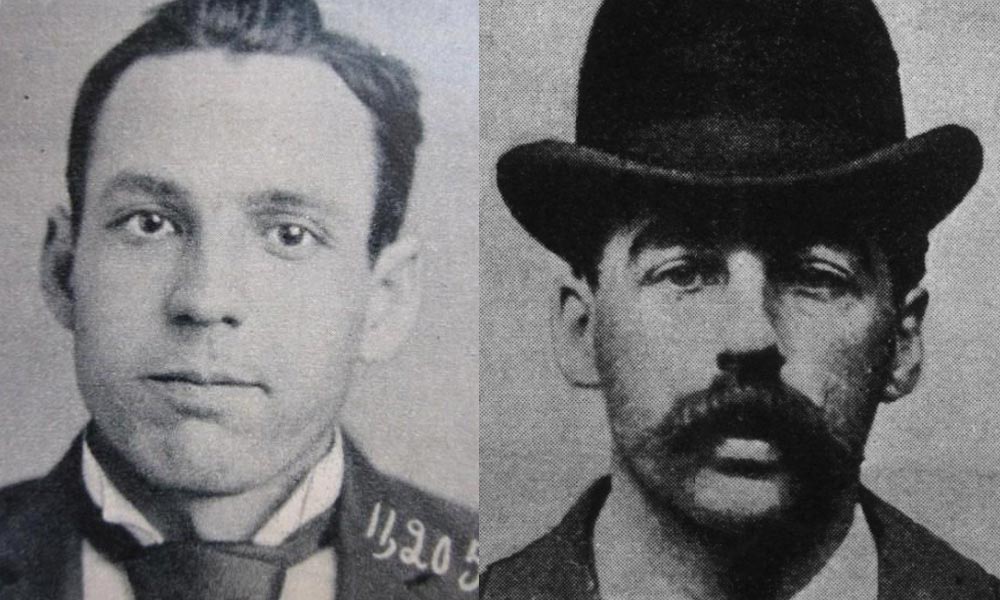
Sierra Mountains Telegraph Line

In the process of doing this, they had to cross over the rugged Sierra Mountains. Less than ten years later the Central Pacific Railroad would spend about 20 million dollars crossing those same mountains. The ground was granite. The winds were strong, and the snow deep.
Get a Free Old West CD With a Photo
 Richard Smith sent Chronicle of the Old West this picture. The note that accompanied the picture said, “I started my printed newspaper last month, I enjoyed the articles. I shot this photo today. Thought you might enjoy it.”
Richard Smith sent Chronicle of the Old West this picture. The note that accompanied the picture said, “I started my printed newspaper last month, I enjoyed the articles. I shot this photo today. Thought you might enjoy it.”
We do enjoy it. Richard also said we could use the picture as we wish. And we will be using it.
This got us thinking. There are probably other people who are creative with a camera who would like to take pictures that include Chronicle of the Old West as a central element.
We’ll be sending Richard one of our story CD’s as a thank you.
Anyone else who sends us a picture we can use will also get a story CD as a thank you.
So, go out there; take a picture with Chronicle of the Old West as a central element; and send it via email to Dakota@RavenHeart.com.
We’re looking forward to hearing from you.
*For More on the Chronicle of the Old West newspaper, click HERE.
Chuckwagon: Cooked Cabbage Salad
1 Pint or more of chopped cooked cabbage
Add:
1 Egg well beaten
¼ Cup vinegar
1 Tsp butter
Dash of salt and pepper
Sweeten to suit taste. Simmer a few minutes and add ½ cup of thick fresh cream. Serve immediately.
*Courtesy of Chronicle of the Old West newspaper, for more click HERE.
SALTED UNDERSHIRT
A SALTED UNDERSHIRT FOR THE GRIP
March 1, 1892, Daily Herald, El Paso, Texas – Five years ago I was suffering with a very severe throat trouble, so much so that I did not expect to live. An acquaintance told me that he could give me a remedy that would cure it and , as I had tried all of the doctors in my town without receiving any benefit, I decided to try the remedy suggested. I tried it, was permanently cured of my cough, and besides I discovered that I was not subject to colds.
I was conductor, running in the states of Virginia, North Carolina, South Carolina, Georgia, Florida, Tennessee and Alabama. I was of course subjected to very hot cars in winter, and of necessity had constantly to get out in the cold at all hours of the night. In all that time I have never had a cold or the grip.
You will be astonished at the remedy. It is simply to wear a salted undershirt. Take a summer undershirt and soak it in brine made with, a half pint of ordinary salt to about a quarter of water, and put out to dry. Wear this shirt next to the body. It is not unpleasant to wear and will, I am sure, keep off grip and bad colds, and, I firmly believe, consumption. If I were to live to be eighty years old, I have so much faith in the salted shirts that I would never cease to wear them. My reason for preferring the thin gauze shirt is because the salt makes a heavy shirt too stiff and hard. Wear the heavy shirt over the salted shirt.
NOTE: This article written in 1892. It was the latest in medical news back then, but not necessarily now.
Rattlesnake Dick

As a teenager, Charlie Lazure came out west to the New Mexico Territory where he got into a shooting fracas. It’s not known what happened to the other guy, but Charlie was shot in the leg, which resulted in his having a limp for the rest of his life.
While out on bond, Charley again stole a couple of horses. And again, he was arrested and brought back to Silver City. This time the complainant showed up, and no one posted bond. As a result, Long Neck Charley spent two years at the Santa Fe Territorial Penitentiary.
 On May 4, 1887, Charley Lazure was released from prison. Not wanting to have anything to do with prison again, he dropped out of sight.Then again, maybe that’s how he picked up the nickname, Rattlesnake Dick. Charley Lazure mayhave just slithered under a rock somewhere.
On May 4, 1887, Charley Lazure was released from prison. Not wanting to have anything to do with prison again, he dropped out of sight.Then again, maybe that’s how he picked up the nickname, Rattlesnake Dick. Charley Lazure mayhave just slithered under a rock somewhere.
The Oxbow Stage Route


Black Faced Charlie & The Dalton Gang


Seth Bullock
 In the Old West there were men who seemed to be everywhere and do everything. Today you’re going to be introduced to one of those men. His name is Seth Bullock.
In the Old West there were men who seemed to be everywhere and do everything. Today you’re going to be introduced to one of those men. His name is Seth Bullock.
In 1867, at the age of twenty, Seth Bullock left Canada to come down to the Montana Territory and do some gold mining. Four years later he was elected to the territory’s state senate. Next Seth took a horseback ride around the Yellowstone area, and sent back reports that helped influence its becoming our first National Park.
Then he became a county sheriff and proceeded to face down a lynch mob, as well as legally hang the first man in the Montana Territory.
Deciding to move on to new territory, he went to Deadwood in 1876. With no law, and no official process of selecting a sheriff, by popular demand, he became the town’s first lawman.
Also being a good businessman, he served as the president of a mining company and a bank.
As a lawman, while trailing an outlaw named Crazy Steve, he ran into a posse led by a deputy U. S. Marshall from the Dakota Badlands who had just caught Crazy Steve. The U. S. Marshall and Seth became lifelong friends. Incidentally, the marshal’s name was Theodore Roosevelt.
Although Seth became a captain in Roosevelt’s Rough Riders, he was never sent to Spain.
After Roosevelt became the President, he sent for Seth, and told Seth that he was needed in Washington. Seth responded that, “There’s just one job that would get me to live in this town, and you’re filling it just fine.” Seth settled for the job of a U.S. Marshal.
Seth served with distinction until his death on September 23, 1919. Roosevelt had called Seth Bullock the ideal American. But he wanted only one word on his tombstone…Pioneer.
Red Cloud
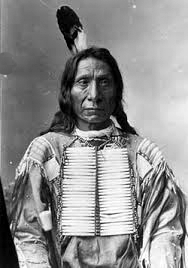 As you will see this week, one of the few times Red Cloud made a miscalculation in his fight with the whites was on August 2, 1867.
As you will see this week, one of the few times Red Cloud made a miscalculation in his fight with the whites was on August 2, 1867.
In July of 1867 civilian contractor J. R. Porter arrived at Fort Kearny in Nebraska with supplies. He planned on starting a logging operation. Among the supplies were 700 new breech-loading Springfield rifles and 100,000 rounds of ammunition. Until now the military had used muzzle-loading rifles. A Springfield used a manufactured cartridge, making it several times faster to shoot than a muzzle-loader.
Porter built his logging camp about six miles from the fort. To carry the logs he took the box beds off about 14 wagons, putting the four-foot high wagon boxes in a circular corral for protection.
At dawn of August 2, 1867 Red Cloud, with almost 1,000 braves, was poised for an attack against the 32 men inside the circle of wagon boxes. Even the women and children of the tribe, had come to observe the event.
At 9:00 500 warriors on horseback made the first charge. They circled the wagons expecting the spaced firing of a muzzle-loader. Instead it was the constant volley of the Springfield. The warriors retreated. Dead and wounded Indians and horses were everywhere. The next wave was 700 warriors on foot wearing nothing but war paint. The Indians got so close and the Springfields were so powerful that one shot often passed through two or three warriors.
For three hours the battle waged on. Then the sound of a howitzer was heard in the distance. A relief column was on its way. Red Cloud and his tribe retreated into the hills.
Miraculously, only 7 of the soldiers and loggers were killed. However, Red Cloud lost over 200 braves.
FORTUNE LOST
During the Old West fortunes came and went. Probably there is no better illustration of the gains and losses than the story of Horace Tabor and his wife “Baby” Doe.
 On March 1, 1883 Elizabeth Doe, later known to the Colorado miners as “Baby” Doe, and Horace Tabor got married. Baby Doe wore a $7,000 gown. Her wedding gift from her husband was a $75,000 diamond necklace.
On March 1, 1883 Elizabeth Doe, later known to the Colorado miners as “Baby” Doe, and Horace Tabor got married. Baby Doe wore a $7,000 gown. Her wedding gift from her husband was a $75,000 diamond necklace.
Five years earlier Horace Tabor was the owner of a general store. He grubstaked a couple of prospectors to about $20 worth of merchandise in exchange for a third share of what they found…What they found was a mine called “Little Pittsburgh” that produced $20,000 worth of silver per week. Horace Tabor decided his fortune was in silver mining. Right after this Tabor bought a mine from a scam artist who had “salted” it with silver. To the chagrin of the scam artist the new mine ended up out producing his first.
Following the wedding Horace and Baby Doe moved into a mansion and had two children. Over the next few years they lived an extravagant lifestyle. But by the late 1890’s, because of federal legislation, the market for silver took a dive. Horace and Baby Doe ended up living in a hotel room.
In April of 1899 Horace Tabor died. His last words to his wife were “Don’t give up the Matchless, for it will make millions again.”
Baby Doe moved to the Matchless Mine located at an elevation of over 10,000 feet, and for 35 years she lived in a shack. She wrapped herself in burlap to keep warm. Early in 1935, during a severe snowstorm, she froze to death.
What she didn’t know was that even if silver was discovered on the Matchless, it would have done her no good. Her husband had lost the Matchless with his other assets before he died.
LIKE LIVER?
On January 21, 1900 one of the Old West’s most intriguing and gruesome men died in a veterans’ hospital in California. This was a strange ending for this man who was depicted in a movie Starring Robert Redford called “Jeremiah Johnson”.
John Johnson was a red bearded giant of a man who headed to the mountains when most mountain men were leaving them.
Early on Johnson came across a covered wagon that had been attached by Indians. The only survivor was the mother, and she had been driven mad from the experience. Over the years John Johnson provided her with food. The Indians left her alone because they were in awe of those who had been driven mad from the touch of the Great Spirit.
Johnson took a Flathead woman as his wife. One day when he was away trapping, a Crow raiding party killed his wife, and the baby she was carrying.
This started the legend for which “Liver-Eating” Johnson is known. For 20 years Johnson took revenge against the Crow in a savage and bloody way. He supposedly killed as many as 300 Crow Indians, with a few Sioux thrown in for extra measure. And legend says he ate the livers of the Indians he killed.
Later “Liver-Eating” Johnson came out of the mountains, and joined the Union Army during the Civil War. After the war, he was a deputy sheriff in Wyoming.
As he got older, Johnson wisely made peace with the Crow Indians. And on January 21, 1900, he died in a veterans’ hospital in California.
Why did John Johnson eat the livers of the Indians? Was he a cannibal? Technically, yes. But Indians often ate the raw liver of animals they killed. They believed it would transfer the power of the animal to the hunter. Maybe he wanted the Indians to think that anyone who would do something this gruesome was touched by the Great Spirit.
SAMUEL COLT
Samuel Colt’s single action revolver, known as the “peacemaker” is a staple to any story about the Old West. But chances are we wouldn’t have ever heard of Colt had it not been for an event that took place on January 4, 1847.
As the story goes in 1830, on a sea voyage to Singapore, Samuel Colt whittled out a wooden model of his revolving handgun. A year later he made two working models, and applied for a patent.
At the time of Colt’s invention, pistols were though of as dueling weapons. The much more accurate rifle was preferred for long distant shooting. For close up self-defense fighting most men preferred knives.
But Colt was sure his pistol would be in great demand. And by 1836 Paterson Colts were coming off the assembly line in Paterson, New Jersey. The Texas Rangers started using the Colt pistol. But they found it to be light, and didn’t hold up well when used as a club to hit someone on the head. So, Samuel Colt made a heavier model, and called it the Walker Colt after Texas Ranger Samuel Walker.
But the demands for Colt pistols weren’t great enough to keep his plant going. And in 1842 Samuel Colt went bankrupt. Giving up gun making all together he started designing submarines.
Then the war with Mexico broke out, and the U. S. government started looking for weaponry. And on January 4, 1847 the government placed an order with Samuel Colt for 1,000 of his .44 caliber revolvers. Colt .44’s served the military so well that the government kept placing orders.
Now infused with capital, Colt developed a system of mass production and interchangeable parts, making his pistols affordable for the average person. And Samuel Colt never looked back. From 1850 to 1860 he sold 170,000 small “pocket” revolvers and 98,000 larger “belt” revolvers…mostly to civilians.
A STRONG MAN & HORSE
In the Old West men and horses were called upon to perform great feats. But no man and horse did more in a short period of time than John Phillips and a big gray thoroughbred.
It was a cold December in 1866. Fort Phil Kearny was being harassed by Red Cloud and his band of Sioux. On the 21st of December Captain John Fetterman and 80 men left the fort to chase after a small group of Indians. The Indians were decoys, and Fetterman’s command was ambushed. Within minutes everyone was killed.
It was necessary for someone to travel to Horseshoe Station, 190 miles away, and telegraph Fort Laramie for reinforcements. That responsibility fell on John Phillips. He wasn’t a member of the military, but a local prospector who had brought his family to the fort for protection.
Riding a big gray thoroughbred, given to him by the fort commander, John started on the trip wearing a buffalo coat to protect him from the severe cold spell they were having.
Hiding during the daylight hours, John still ran into war parties, but the long legged thoroughbred was able to outrun the smaller Indian ponies. On December 24th John arrived at Horseshoe Station, but they were unable to send a telegraph to Laramie, because the line was down…either the result of Indian activity or the weather. Jumping back on his horse, he rode the remaining forty miles to Fort Laramie. A Christmas party was in progress when John arrived. A half frozen John Phillips entered the hall, told his story, and collapsed on the floor. Early Christmas day a column headed for Fort Kearny.
Although, at the time no one thought the 230-mile ride from Fort Kearny to Fort Laramie was anything more than a long cold ride, but shortly afterward it reached the level of myth…a man and horse enduring devastating weather and wild Sioux to save a beleaguered garrison.
SLOW
 As a young boy his father gave him the name “Slow”. But during a raid against the Crow, at the age of 14, Slow raced ahead of his fellow warriors, and made the first kill. His father immediately changed his name. You may be surprised when you learn his new name.
As a young boy his father gave him the name “Slow”. But during a raid against the Crow, at the age of 14, Slow raced ahead of his fellow warriors, and made the first kill. His father immediately changed his name. You may be surprised when you learn his new name.
His father gave him the name of “Slow”…not because he wasn’t bright…but because he was deliberate. But his “deliberateness” never stood in the way of him taking action. At the age of 14 he made his first kill, and his father changed his name to…Sitting Bull.
Sitting Bull is best known for his victory at Little Big Horn against George Armstrong Custer. As strange as it may seem, his victory directly resulted in his defeat. But I get ahead of myself.
Because of his braveness in battle Sitting Bull was soon made the leader of the Strong Hearts, a special society of warriors…and later he became the chief of his Hunkpapa division of the Sioux.
Sitting Bull had special abilities as a leader and organizer. Even though the Federal Government had ordered the Indians to relocate to a reservation, Sitting Bull was able to convince more than 10,000 Sioux, Arapaho and Cheyenne to leave the reservation, and band together…and it was a part of this group that defeated General Custer.
Because of Little Big Horn, the government made an all out effort to defeat the Plains Indians. Finally, with less than 200 followers Sitting Bull and his ragged band surrendered.
On December 15, 1890, Sitting Bull was living on the Standing Rock Indian Reservation. Because of fears of an Indian insurrection, about 40 Indian policemen rushed Sitting Bull’s home to arrest him while he was asleep. In the confusion a fight broke out and the great Sioux Chief Sitting Bull was shot twice…by a Sioux Indian policeman. Incidentally, the 59-year-old Sitting Bull had previously indicated he had no interest in the insurrection.
OLD WEST NEWSPAPER
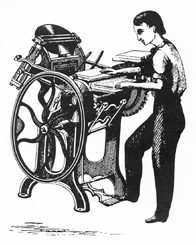 With frontier towns springing up over night, and disappearing as fast, an Old West newspaper had to be on the move to keep customers. This week’s story is about one such newspaper.
With frontier towns springing up over night, and disappearing as fast, an Old West newspaper had to be on the move to keep customers. This week’s story is about one such newspaper.
Following the Civil War two brothers, Legh and Fred Freeman, were hired to publish a newspaper out of Fort Kearney, Nebraska. During this time the railroad passed through the area. While the railroad was being built in the area things boomed. As the railroad moved on, taking the workers with it, there was a bust.
The Freeman brothers hit on the idea to create a newspaper that would move along with the railroad. So, they bought a hand press, type, ink and paper, named their newspaper the Frontier Index, and hired wagons to take them to the next town where the railroad was to arrive. As the crews arrived with men anxious to read the latest news, they did a booming business. Merchants were willing to pay outrageous prices for advertising, and marked their goods up accordingly.
The masthead of the Index changed each time they moved to a new town. During its existence the Index was published in 25 different cities. Sometimes the Freeman brothers moved so fast that they outran their supplies. One time they had to print the newspaper on wrapping paper.
The Index came to an end in Bear River City. As the population of the city grew, the lawless element started arriving along with the railroad workers. The Index wrote an editorial stating, “Bear River City has stood enough of the rowdy criminal element.” The next day, November 15, 1868, some of “the rowdy criminal element” grabbed a rope, and headed to the tent that headquartered the Index newspaper. The Freeman brothers were able to escape, but when they returned nothing remained of the Index but ashes. The lifespan of the Frontier Index was but two years. Which, incidentally, was a long time for a frontier newspaper.
A TOWN TREED
 Hunters are known to tree a mountain lion or a bear now and then, but in 1859, a gang of thugs treed a whole town. That’s right, a whole town.
Hunters are known to tree a mountain lion or a bear now and then, but in 1859, a gang of thugs treed a whole town. That’s right, a whole town.
It was the mid 1800’s. Anglos from other parts of the United States were coming to Texas in groves, and taking over land previously owned by Mexicans.
Juan Cortina, saw his family’s land holdings shrink. When he became a man, Juan put together a gang of disgruntled Mexicans and started taking back some of the land. In mid September of 1859 one of Juan’s men was arrested in Brownsville, Texas. Juan and his men shot the Marshal and freed the gang member. This, of course, infuriated the citizens of Brownsville. For days they talked about putting together a posse and getting revenge. But it seems that talk was all they were want to do.
Juan Cortina, on the other hand, wanted action, and getting tired of waiting for the posse to come after him, on September 27 he led a thousand cutthroats into Brownsville, captured Fort Brown, and took over the town. After killing anyone who had previously caused him grief, Juan demanded one hundred thousand dollars in gold or he would burn down the town.
News of the Brownsville situation got out and a contingency of men came to the rescue. Unfortunately, for them, news of what Cortina was doing also reached his friends and his gang had grown to a much larger size. After defeating the relief column, Cortina went after Edinburg, Texas and then took on Rio Grande.
Cortina then wisely retreated back to Mexico where for 15 years he made raids across the border. Finally in 1875, the Texas Rangers decided to put an end to Juan Cortina’s shenanigans, and went down to Mexico and kicked his butt. From then on Juan stayed south of the border and played politics there.
BATTLE OF BEECHER’S ISLAND
 The summer of 1868, Indians were conducting major raids on railroad work camps and homesteads. Major George Forsyth was ordered to put together a detachment of 50 volunteer frontiersmen to teach the Indians a lesson.
The summer of 1868, Indians were conducting major raids on railroad work camps and homesteads. Major George Forsyth was ordered to put together a detachment of 50 volunteer frontiersmen to teach the Indians a lesson.
The first part of September they arrived at Kansas’ Fort Wallace, and immediately took after a group of Indians who had stolen some stock. On September 16, Forsyth and his men, low on rations, camped on the banks of the Arikaree River.
Unknown to Forsyth 4,000, Cheyenne, Arapaho and Sioux had been following him for three days. The morning of September 17 Major Forsyth and his men were awaken by the sounds of war cries. The 50 volunteers, with their animals, retreated and dug into a 40-yard by 150-yard sandbar.
By 9 A.M. the Indians had killed all of the volunteers’ horses and mules. Now there was no way of escape. A half hour later 300-mounted warriors, headed directly for the 50 volunteers. But, what the Indians didn’t realize was that all of Forsyth’s men were equipped with Spencer seven-shot repeating rifles and Colt pistols. Waiting until the last second to start firing, the charge was broken.
For eight days the Indian attacks continued, and the Spencer rifles kept them away from the volunteers. Two of the volunteers were able to get away and make it to Fort Wallace for help. By the time reinforcements arrived, the bulk of the Indians had left, with only a small contingency staying to starve out the volunteers.
Technology had made it possible for 50 men to face and essentially defeat a force of 1,500 warriors. During the battle, 10 of the volunteers were killed, and 20 wounded. But Indian causalities were estimated to be around 50 killed and as many as 200 wounded.
TODAY’S HERO – TOMORROW’S BUM
Often things moved fast in the Old West. Today’s hero is sometimes tomorrow’s bum. Or, in Caldwell, Kansas to day’s hero is tomorrow’s dead bum.
day’s hero is tomorrow’s dead bum.
Born in Tennessee, George Flatt, went out to Caldwell, Kansas. George had a bit of a stubborn streak that came out in July of 1879. After more than a few drinks, a couple of cowboys in the Occidental Saloon started shooting their pistols. Constable Kelly and a posse that included George Flatt came to take care of the problem. The posse cautiously entered the saloon, and saw the two cowboys with their guns pointed at them. The cowboys started for the door. But Flatt stepped forward and blocked the door. Carrying two guns, the cowboys demanded that he drop them. Flatt responded, “I’ll die first.” A shot from one of the cowboys whizzed past Flatt’s head. Flatt went into action. Each gun took out a cowboy.
Things moved fast in Caldwell. In a matter of weeks, George Flatt advanced from posse member to the city’s first marshal. And capitalizing on his new found fame he went into partnership with William Horseman operating a saloon.
But many times as fast as things go well, just as fast they turn bad. Flatt was a heavy drinker. And within a year not only had his partnership with Horseman fallen apart, but Horseman had even replaced him as city marshal.
Then on Saturday evening, June 19, 1880 after spending some time drinking in the bars, George Flat headed for home. From the dark a rifle shot rang out. It hit Flatt in the skull. Once he was down, three more slugs filled his body. Yes, things moved fast in Caldwell, Kansas…From a marshal and businessman to a dead drunk laying face down in the dirt in less than a year.

